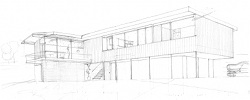tour: in-progress renovation of midcentury ranch
Homeowner Paul Hickman (owner of Urban Ashes) is opening the opportunity to experience a rare hands-on opportunity to visit an in-progress transformation of a historic mid-century modern ranch featuring a multitude of unconventional and reclaimed materials from the site and beyond.
The next installment of the Visible Green Home™/Behind the Drywall™ Tour showcases the “story” behind a home and the owner’s 18 years of professional experience specifying sustainable finishes and materials as a consultant/designer. This mid-century modern, dubbed “Rancho Deluxe”, is being revived utilizing many of the same materials deconstructed from the site during the renovation. With these materials from the site, along with other unconventional and reclaimed materials, Rancho Deluxe creates a unique sense of place that respects the history of the home while looking to the future. Where new materials and fixtures are required, the focus is American made, locally sourced, or reclaimed whenever possible.
Guided tours will take place on Saturday and Sunday, December 8th and 9th, 2012. The event is free however; pre-registration is required by visiting www.behindthedrywall.com or by calling 734-619-8024.
Some key materials and their stories:
• The original Redwood clapboards, unearthed under the 1970’s vinyl siding, will be repurposed as siding for the new Urban Ashes studio on site.
• The old vinyl siding went to another homeowner to clad a new addition and garage.
• All of the ½” rigid foam from under the vinyl was salvaged and is being reused on site as a component of the new thermal envelope.
• The new exterior house siding and trim is sourced from 100 year-old Michigan barns, once at the heart of the state’s agriculture infrastructure, and now diverted from the landfill.
• The concrete patio material, removed to insulate the foundation, was salvaged and will be utilized on site for retaining walls and as broken pavers.
• The existing interior doors, plumbing & lighting fixtures, laminate flooring, appliances and mechanical fixtures not vintage to the house or era, were donated to local charities or relocated to new homes.
• All of the new interior doors will be vintage “Miracle” doors sourced through Reclaim Detroit from deconstructed Detroit homes slated for landfill.
• New flooring, trim, and cabinetry designed by the homeowner in a 1940’s style, will be crafted from trees downed by the Dexter Tornado of 2012, and from the only large tree removed from the site necessary to fully expose the solar array used to power the home and studio year round.
• The new interior color palette, designed to pay homage to the 1940’s, will be created using petroleum-free, non-toxic, plant oil-based paints.
About the Tour Organizers
This tour is being organized by a collaborative of local companies which include: Meadowlark Energy, Architectural Resource, Urban Ashes, Thrive Net-Zero Collaborative, Renovo Power Systems, Wood Window Repair, Land Architects, Brian Schmidt Carpentry, Nicki Wilson Lighting, Big George’s, Bgreen Today, Neighborhood Roofing, 2nd Chance Wood Company, and Reclaim Detroit. For more information go to www.ranchodeluxe.info



